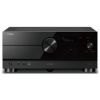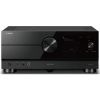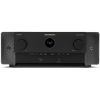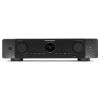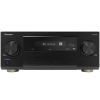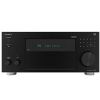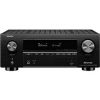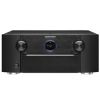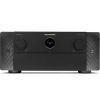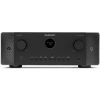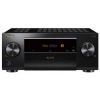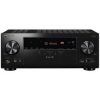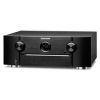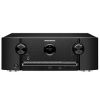Yamaha TSR-5810 vs Yamaha RX-V485 review
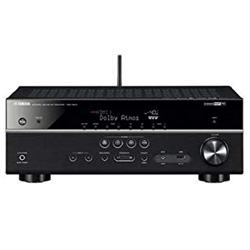
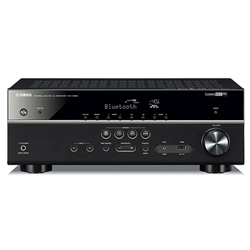
An overview of Yamaha TSR-5810 and Yamaha RX-V485 will help us understand the many features that the devices are equipped with. According to the results of our review, Yamaha TSR-5810 received 6.7 points out of 10 possible, and Yamaha RX-V485 was rated 7.4 points. The release date of TSR-5810 is 2016, and RX-V485 is 2018. And as a result of the review, it becomes clear that TSR-5810 is inferior in audio processing features to RX-V485.
Main advantages Yamaha TSR-5810 over Yamaha RX-V485
- ✔More channels, namely 7, makes this receiver more profitable than its 5-channel competitor.
- ✔Surround sound ensures the availability of Dolby Atmos.
- ✔Object-oriented sound ensures the availability of DTS:X.
Main advantages Yamaha RX-V485 over Yamaha TSR-5810
- ✔Include HDMI eARC function.
Amplifiers
For the built-in amplifier, the devices received different marks - 7 and 6, respectively, on a 10-point scale.
The number of channels is equal to the number of possible connected speakers. The Yamaha TSR-5810 supports 7.2-channels sound, but Yamaha RX-V485 supports a 5.1-channels configuration.
RMS stands for the actual power of the receiver. The higher this value, the louder the sound can be produced. In terms of RMS power, the models have the same characteristics - 80/8, 145/6/8 W/Ohm.
| TSR-5810 | RX-V485 | |
|---|---|---|
| Channels | 7.2 | 5.1 |
| Stereo power (RMS), W/Ohm | 80/8, 145/6 | 80/8, 145/6 |
| Output impedance, Ohm | 8, 6 | 8, 6 |
| Frequency response | 10Hz-100KHz | 10Hz-100KHz |
| THD in stereo, % | 0.09 | 0.09 |
Audio features
After reviewing the audio features of each model, we can rate the TSR-5810 8 out of 10, and the RX-V485 - 9.
Most receivers now come with a microphone included. It is with the help of this microphone that the auto-calibration system functions, which adjusts the sound of the receiver to the room.
| TSR-5810 | RX-V485 | |
|---|---|---|
| Digital to analog converter (DAC) | Burr-Brown 192 KHz/24-bit | Burr-Brown 384 KHz/32-bit |
| Bi-amping | ✔ | ✔ |
| Pure direct (straight) | ✔ | ✔ |
| Auto speaker calibration | YPAO | YPAO |
| Speaker A/B switching | ✖ | ✖ |
| Other audio features | CINEMA DSP, Compressed Music Enhancer, Virtual CINEMA FRONT, Extra Bass | CINEMA DSP 3D, Compressed Music Enhancer, Virtual CINEMA FRONT |
Connectivity
The connectivity of competitors in our comparison is markedly different, Yamaha TSR-5810 scored 8, and Yamaha RX-V485 scored 7 out of 10.
Bluetooth connection is now one of the main communication protocols for the receiver's control or even music broadcasting.
DLNA is the perfect way to use your local cloud storage to stream movies and music directly to a TV. You can use the DLNA protocol only with Yamaha TSR-5810.
| TSR-5810 | RX-V485 | |
|---|---|---|
| Wi-Fi | ✔ | ✔ |
| USB | 1 (USB 2.0) | 1 (USB 2.0) |
| Bluetooth | ✔ | ✔ |
| Ethernet (RJ45) | 1 | 1 |
| DLNA | ✔ | ✖ |
| MHL | ✖ | ✖ |
Streaming services
Now music streaming services are gaining more and more popularity. They allow users to listen to millions of songs by subscription.
| TSR-5810 | RX-V485 | |
|---|---|---|
| Apple Music (AirPlay) | AirPlay | AirPlay, AirPlay 2 |
| Amazon Music | ✖ | ✔ |
| Spotify | ✔ | ✔ |
| Other streaming services | Pandora | Deezer, TIDAL, Pandora, Napster, SiriusXM |
Extensive connections
The presence of many connectors makes the receiver more versatile. But there are also narrowly targeted models, the number of connectors which are limited to a certain area of use. And when choosing their own receiver, users need to consider exactly your goals for using the receiver. For extensive connection, Yamaha TSR-5810 got 6 points, but Yamaha RX-V485 received 8 points.
Competitors in our review have 4/1 HDMI inputs and outputs.
HDMI eARC is the next step in the development of audio return channel technology, which works in conjunction with HDMI 2.1. Using eARC provides the highest sound quality for home audio systems. HDMI eARC is available on Yamaha RX-V485.
The HDCP encryption protocol is now mandatory for most media devices. This security technology encrypts digital signals from one product to another. HDCP content-encryption protocol is present on Yamaha TSR-5810 in the HDCP 2.2 version, and Yamaha RX-V485 has the HDCP 2.3 version.
| TSR-5810 | RX-V485 | |
|---|---|---|
| HDMI input/output | 4/1 | 4/1 |
| HDMI ARC (Audio Return Channel) | ✔ | ✔ |
| HDMI eARC (Enhanced Audio Return Channel) | ✖ | ✔ |
| HDMI CEC | ✔ | ✔ |
| Digital content protection (HDCP) | HDCP 2.2 | HDCP 2.3 |
| Subwoofer output (LFE) | 2 | 1 |
| Headphone output | 1 x 6.3 | 1 x 6.3 |
| Optical digital input | 1 | 1 |
| Coaxial digital input | 2 | 2 |
| Composite input | 3 | 3 |
| Component input/output | 0/0 | 0/0 |
| Phono (MM) input | ✖ | ✖ |
| Front panel connectors | USB, phones, setup mic, AUX | USB, phones, AUX |
| Multi channel preamp output | ✖ | ✖ |
Video features
The AV receiver is the heart of the home theater. And in this case, support for all current video formats ensures the best user experience, so it is very important to consider this when choosing a device. Video features of the TSR-5810 were rated 6 out of 10 against the 9 for the RX-V485.
Most of the AV receivers have a video scaling function, it is the process of reformatting the video signal to a higher resolution without losing the quality of the image. Upscaling the video signal resolution is possible with Yamaha RX-V485.
| TSR-5810 | RX-V485 | |
|---|---|---|
| HDR (High Dynamic Range) | ✔ | HDR10 |
| 4K signal pass-through | 4K/60Hz | 4K/60Hz |
| 8K signal pass-through | ✖ | ✖ |
| HDMI signal pass-through | ✔ | ✔ |
| 3D signal pass-through | ✔ | ✔ |
| HDMI pass-through in standby mode | ✔ | ✔ |
| Video conversion | ✖ | ✖ |
| Analog to HDMI scaling | ✖ | ✔ |
| HDMI to HDMI scaling | ✖ | ✔ |
| Dolby Vision | ✖ | ✔ |
| Other video features | DeepColor, x.v.Color | DeepColor, x.v.Color, BT.2020, HLG |
Additional features
In terms of evaluating additional features, both receivers received a score of 9 out of 10.
| TSR-5810 | RX-V485 | |
|---|---|---|
| Voice control | Amazon Alexa | Amazon Alexa, Google Assistant, Siri |
| App control | iPhone, iPad, iPod, Android | iPhone, iPad, iPod, Android |
| Display | colour OSD | colour OSD |
| Tuner | AM, FM | AM, FM |
| Sleep timer | ✔ | ✔ |
| Auto power off | ✔ | ✔ |
| ECO mode | ✔ | ✔ |
| Graphical user interface (GUI) | ✖ | ✖ |
| Setup assistant | ✔ | ✔ |
| Firmware update | network, USB | network, USB |
| Other additional features | has not | has not |
Multi-room
As the center of a home media system, each multichannel receiver has an additional set of terminals for connecting the second set of speakers to create additional audio space in Zone 2 or even Zone 3 where audio can have the separate source.
| TSR-5810 | RX-V485 | |
|---|---|---|
| Multi-room zones | 2 | 2 |
| Zone audio output | speaker | speaker |
| Zone HDMI output | ✖ | ✖ |
| Multi-room control | MusicCast | MusicCast |
| RS-232 | 0 | 0 |
| Remote control input/output (IR) | 0/0 | 0/0 |
| DC trigger output (12V) | 0 | 0 |
Multichannel surround
Yamaha TSR-5810 got 7 points for the multichannel surround sound and Yamaha RX-V485 got 5.
Dolby Atmos' particularity is that this is the object-oriented sound format, that is, each audio signal object is independently sounded and connected to its spatial position. Yamaha TSR-5810 can create 3D sound due to the Dolby Atmos support.
DTS:X is an algorithm used by the processor to create sound scenes, where sounds connected directly to objects rather than channels, and to determine the optimum sound output distribution in space. Surround sound with DTS:X is available only on the TSR-5810.
| TSR-5810 | RX-V485 | |
|---|---|---|
| Dolby Atmos | ✔ | ✖ |
| Dolby TrueHD | ✔ | ✔ |
| Dolby Surround | ✔ | ✖ |
| Dolby (other) | Dolby Digital Plus | Dolby Digital Plus, Dolby Pro Logic |
| DTS:X | ✔ | ✖ |
| DTS HD Master | ✔ | ✔ |
| DTS Virtual:X | ✖ | ✖ |
| DTS Neural:X | ✔ | ✖ |
| DTS (other) | DTS-ES, DTS 96/24, DTS-HD, DTS-EXPRESS, DTS-Surround, DTS-Neo:6 | DTS-ES, DTS 96/24, DTS-HD, DTS-EXPRESS, DTS Neo:6 |
| Auro-3D | ✖ | ✖ |
| IMAX Enhanced | ✖ | ✖ |
| Multichannel stereo | ✖ | ✖ |
Popular receiver comparisons
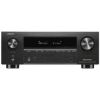
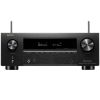

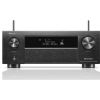
Latest receiver comparisons







